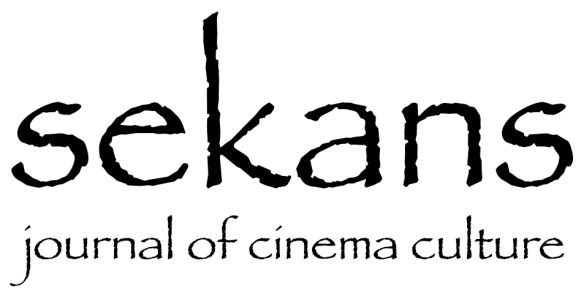ON BODY AND SOUL
A STATEMENT AS PURE AS A DEER
Seda Usubütün
On Body and Soul (Teströl es Lelekröl, 2017) is the story of two naive people who feel emotional intimacy towards each other in the setting of a slaughterhouse. The Hungarian director Ildiko Enyedi builds the main tension of the film by putting the warmth of the intimacy amongst living creatures against the mundane harshness of the world. When the cattle are chopped in the slaughterhouse, the characters of the movie turn their faces towards the sun for the purpose of warming up their souls. When bodies are splintered, souls shelter the closest warmness and light they can find.
Before introducing the characters of the film, the thin line between introversion and autism should be mentioned. One is a personality trait, the other is a clinical diagnosis; two separate dimensions for mental health professionals. Introversion is the lack of interest into and desire of a connection with the environment. It is a shy, reserved and silent existence. It is thought of as a choice, instead of a personal disposition. On the other hand, autism is a serious pathology hindering individuals to get involved in social life. It is not a choice but an imperative. However, at different degrees of autism, some cognitive and social malfunctions may change and differentiate with the compliance mechanisms of the patient. Although the female character on On Body and Soul, Maria, has been drawn to exhibit typical features of Asperger's Syndrome for those familiar with the clinical spectrum of autism, for the ordinary audience, she is a cold and uncommunicative person who lives and make others live difficulties in social life, she is introvert and a little ‘’disturbed’’. Some ‘’strange’’, ‘’bizarre’’, ‘’incomprehensible’’ behaviours of her may make our judgement difficult, but the knowledge that will ensure us to perceive her as “pathological” is deducted from the film. So it's better to think of this character in the gray area between mild autism and severe introvert.

A Man, a Woman
The female character, Maria (Alexandra Borbely) is in a state of disconnectedness that deserves the "ice queen" nickname in her new workplace working as a quality supervisor. Maria spending all day in the cold slaughterhouse in the blue light of the computer with wearing her beanie is a woman who rejects her colleagues’ coffee invitations, do causes other people to “freeze” when she sits at their table in the cafeteria, behaves uninterested and does not care much about communicating with others. She finds herself as someone whom her colleagues gossip about, laugh at and mock, although she doesn’t mind. Maria only cares about her work, she closes herself to the environment. When the people around cares for her, she has never had difficulty in pushing them away due to her undeveloped social skills. She feels extremely uncomfortable when somebody touches her. Even though this contact is made accidentally and without any harmful intention, her body is alarmed and shows avoidance response. It is a reaction of an organism that has already been enclosed inside. The outside world is full of these kinds of unexpected stimuli and threats. In her house, on the other hand, which is the most safe place for her, she has certain routines and diligence. Her life must be organized and operated perfectly. She can only cope with a small amount of objects, actions and stimuli at certain time and space. The only way for her to be purposeful and focused in life is that she does not go out of this order she has established for herself. Her little world commits just like a precise clock, always the same way she consumes her moments. It seems like a spirit does not accompany her body in this life of mechanical functioning. In rare moments when she turns her face to the sky, can solar rays find ways to enter her body to warm her? We can't even be sure of that.
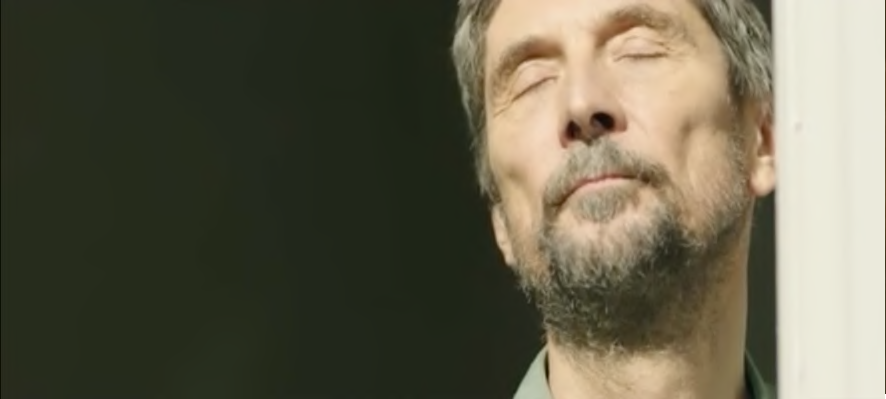
The male character of the movie, Endre (Geza Morcsanyi), is a finance manager who ‘’never visits the altar’’ in the slaughterhouse. He only shows himself in his office, food court and seldomly at the cafeteria. His only friend is the human resources manager, but he turns a cold shoulder as if he didn’t choose him to be his friend but couldn’t say no. Endre is good at his job and his left arm is paralyzed. We cannot know which of these two features of him is more important in his gaining distant respect from the people around him. He lives alone, has his dinners mostly at the outside and falls asleep in front of the television at nights. The spirit that accompanies the movements of his disabled body through life is delicate and fragile.
About body and soul...
Body is concrete, consists of flesh, bone and blood. Soul is abstract. It is incorporated to the body and encompasses other indefinable features of ours that complete the body. Our mental functions, cognitive capacity, feelings, desires and dreams -they all can be implicated in the soul. The duality of body and soul is one of the oldest and most fundamental issues of philosophy. In Cartesian thought, the proposition of Descartes ‘I think therefore I am’ (cogito ergo sum) leaves no room for a metaphysical spirit. Soul and mind, mind and thought are paired. With the post-Cartesian thought, the world of unconscious experiences, instincts, dreams, and emotions, as well as conscious thinking have been included to the existence, and soul (psyche) has been considered as a viable category of existence. (Thanks to Freud and his contemporaries) The soul and body, which always interact with each other, the mirror of one another, have transcended this dichotomy in contemporary philosophy, becoming one and whole (here, let's give credit to phenomenology and post-structuralists). Another explanation from psychology is Rollo May's analysis: Descartes's exclusion from the entity is not only about the soul but the power of action. The will and intentionality that make individual human are not only the power to think and design. The transformation of intentionality to an entity is possible only if abstract ideas and plans can take action and become concrete. This approach delivers credibility not only to the brain but to the whole body. ‘’Instead of saying I think therefore I am, it would be more accurate to say I act intentionally therefore I am.’’ says Rollo May.
There are many junctions in the road of human intellectual history that scrutinized from the philosophical concepts such as intent, will, self-control and intentionality to the ‘’body’’ and ‘’soul’’ which are considered as two main categories of the existence. With the most valid approach, when we see body and soul as an inseparable whole, the question whether the cognitive system (thinking-interpreting-designing-dreaming-reminiscence) is the function of body or soul loses its meaning. Of course, they contribute these functions together. Neurobiological system, on one hand, cognitive psychological mechanisms on the other and socio-cultural interactions for sure; aren't they all sine qua non components of thinking, feeling, and forming relations?
‘’Body’’ representations in the movie
The deer in the dream: Their existences, movements, interactions, glances, touches in the forest. The two deer interacting with each other in the eye of the audience with the nuanced editing of the director. The linear narration reflected by the nonverbal communication of their bodies. First, they are in their own, separate from the herd, and from each other, over time they notice each other, watch remotely, be side by side without touching, lose sight, move together, get closer and have small contacts. They symbolize free bodies integrated with nature. Strong on their own, but not disconnected, bodies that can form relations; unlike the bodies in the slaughterhouse.
Bonding, connecting to a living, feeling attached, living connections. Are they closer to the body or the soul?
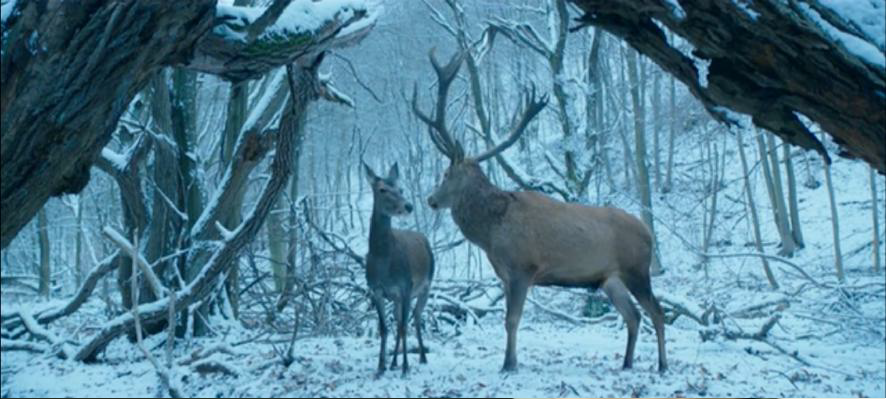
Animals in the slaughterhouse: It is inevitable to include the captived and shattered bodies in this film. Flesh-bone-fat-blood images are clearly displayed in all processes where cattle are shattered to obtain meat. The movement of animals before slaughter, their gaze, their disengagement in a herd. The director shows us their expressions in close-up shots, and we assign feelings to them: concern, fear, indifference, shortsightedness, unresponsiveness. (drugs should be mixed in their meal, as we also know about their drug for fast mating).
The scene of the slaughterhouse employees who follow the animal scenes in the slaughterhouse should not be overlooked. Similarities are constructed between them: being a member of a herd/community, being processed by some mechanism, and giving the right to self-determination unconsciously to the social compromises.
Physically disabled characters: Both characters are prominent with bodily existence due to their physical pathologies.
Endre's left arm is crippled, paralyzed. It is a dysfunctional body part hanging down his shoulder, with no sense and strength. Endre’s adaptation ability is strong. With his rugged right arm, he accomplishes everything like a single-gun musketeer. We don't know the story of this injury. Is he born with it or not? We have no slightest idea of what Endre would be if he didn't have this disability. But, partially, he has some manners and attitudes that we can tie to this disability. His fragility and shyness to initiate a relationship or his lack of courage in pursuing his desires should not be independent of his physical disability.
Maria’s physical limitations are more serious. Even though the movie doesn’t show us clearly, we understand that she is diagnosed with Asperger’s Syndrome, a clinical diagnosis refers to the cases in the autism spectrum with advanced cognitive ability. The strength of Maria is her memory. She can remember all past events with specific day-month details and all of her interactions with others, even the sentence order. However, having strong memory doesn’t neutralize the other characteristics of autism. Autism is a clinical diagnosis that has a genetic origin, is mostly diagnosed at early ages and shows symptoms such as problems in social development and communication, hypersensitivity to the external stimuli, restrictive-repetitive behaviours. It is a situation characterized by the lack of empathy, emotional language and eye contact in communication, and a reserved mental state. In the movie, Maria was presented to the audience as an ideal case with almost all of these clinical features. Only the name of the diagnosis is missing.
Maria's physical posture is rigid as a stick, body movement is mechanical and face is impassive. As Zsoka, the cleaning worker of the slaughterhouse, expresses how important the movements of the human body are! Although our postures and movements are much more stimulating than clothing, they are being ignored while preparing for a performance in the outside world. Probably Maria's introverted attention has rarely met with mirrors.
How will it be possible for these two defective bodies to connect with each other?
‘’Soul’’ representations in the movie
Sharing the dream: Two sensitive people have the same dream, know each other by their deer form in the dream world, shelter in each other in a cold forest, and protect each other. Of course, this dream part binding the souls of characters together is a filmic invention. A metaphor. The metaphor of the belief that two people who are deprived of the ability to find and connect to each other in real life, in fact, may actually have a chance with each other.
Animals in the slaughterhouse: The cattle which have no ability and power to object to their situation are at close up shot, which evokes empathy on the audition. It can be seen as the director’s attempt to give back their souls to them. Which audience can remain indifferent to this? Is there anyone who watches the scenes and doesn’t question: ‘’Do I have the right to harm them in such a way?’’ Don’t we say: ‘’Screw this mutual agreement we make on animals!’’
In the job interview of new employee Sandor, Endre makes this advice: ‘’If you don’’t feel sorry for these butchered animals, you can’t work in the slaughterhouse.’’ Does this statement also warn us against the indifference of perceiving these animals as just a piece of meat? It is our emotions that connect with the soul and if they are oppressed, they result in depression and absorb the life energy. I transferred to the present, the compassionate and respectful point of view for the slaughtered animals, from natural relationships between humans and animals in predatory societies, Enyedi says in her interviews.
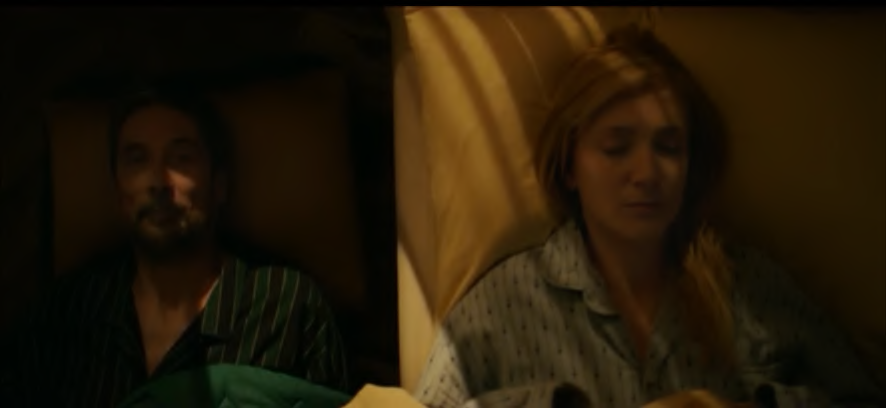
The interaction between Maria and Endre: They are in a connection that similar to the deer: they can observe, glance at each other from a distance, feel their existence and interact even without verbal communication. Big misunderstandings, however, happen in their face to face and oral communication. They experience weak dialogues mostly because of Maria’s autistic nature but Endre’s fragile and sorehead characteristic is also a factor. Their oral communication attempts fail, despite Maria’s talking rehearsals, but how wonderful the dreams and faint sensation nurtured by dreams work for getting them closer to each other. Despite physical limitations, their souls draw each other like magnets.
Pain and joy intersecting the body and soul
Pain and joy get coded with negative or positive emotions affecting both body and soul at the same time. While the flesh-bone-blood images in the slaughterhouse symbolize body and pain it the movie, the sun coming out occasionally symbolizes soul and joy of life. (all hail to Spinoza)
If we focus on what characters experience:
Pain for Endre: The moments when Maria points out his disabled arm; when he is warned about his glance to psychologist’s breast; when new employee Sandor is interested in Maria (what a quick reflex of jealousy and sense of protection); when Maria flinches herself because of his touch after a long night in the Endre’s house. Whenever expectations and reality contradict each other.
Pain for Maria: No or very few feelings like other feelings of Maria. Maria shows no empathy sign for these interactions affecting Endre negatively. No feelings by her autistic nature. She is indifferent to anything but the sun… and music. Not every song, just one song. ‘’What He Wrote’’ by Laura Marling catches her feelings at the first listening.
He wrote, ‘I'm broke, please send for me.’ But I'm broken too, and spoken for. Please, do not, tempt me
The song impressed her deeply such a way that she pauses the song in this part...
When she screws up her courage after touching practices and insistent observation on couples making love in the park, and goes to Endre with her pyjamas and full commitment, she is rejected by Endre. This rejection must be the ‘’pain’’ in the sense we know. Whenever expectations and reality contradict each other...
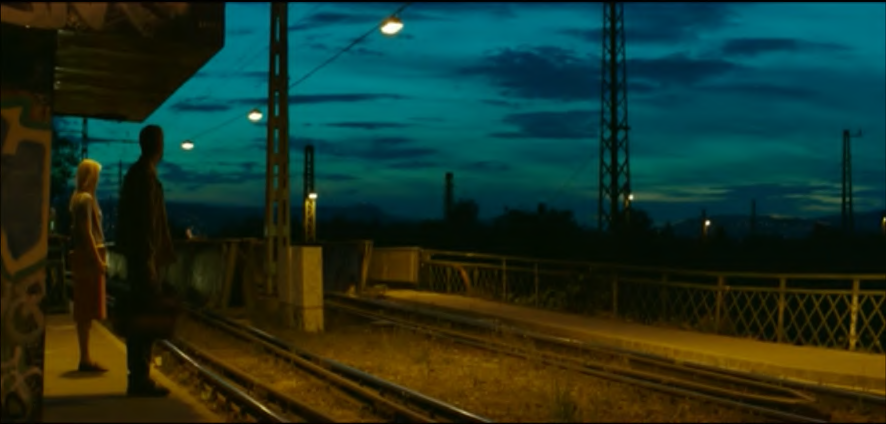
Joy for Endre and Maria: The moment in the train station after their mutual dreams approving that their intuitional attention towards each other and non-verbal but sensitive interaction comes out. This is a pre-joy. The true joy happens when the dreams are written and compared, and this miraculous situation is approved undeniably. The moment when their so much loving each other starts. The moment when they sense bonding through their eyes, and share mutual warm smiles. When Maria discovers the real eye contact. The irrevocable moment for each of them.
Wish dream came true
These two characters would never find each other, neither in the movie life nor in real life, without dreams. However, doesn’t the dream theme show us the imagination of the director, and not of the characters? These dreams can’t be created just for making a love relationship possible. Enyedi must have set up a dream setting for our real (and cruel) world that we all experience more or less defects and make mistakes while trying to achieve a connection, she dreams for us, and share her dream with us. She explains us that as living creatures, our body and soul mechanism which enables us to connect with each other rests in our deepest layers, and this mechanism is both simple and primitive (as animals), and sophisticated that needs going down into those depths (as humans). She must be telling that combining the body and the soul in relation to life requires a design and imagination that can go beyond everyday ordinary interactions with our environment. I imagine, therefore I can connect.
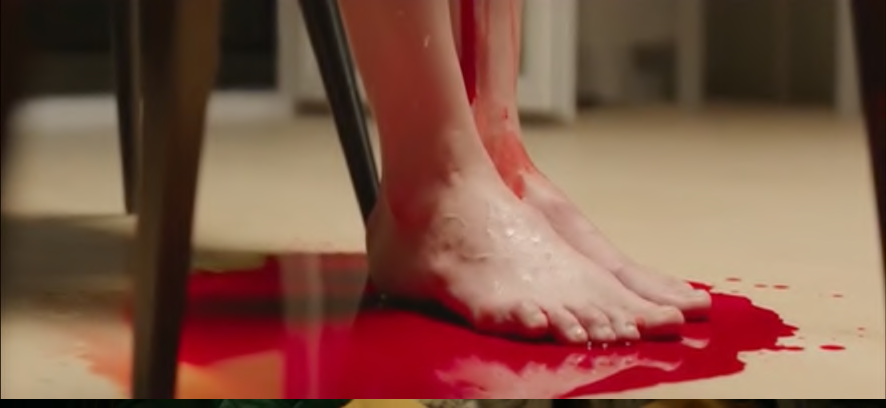
In today’s cruel and chaotic world, is the call from Enyedi sufficiently convincing to go beyond copulating and fucking each other, and to return to our needs to connect with each other in our purest state to establish bonds, and to re-open ourselves to our most fundamental human value, spiritual and physical sharing? From its scenario to acting, from its images to soundtrack, from its symbolism to fiction, On Body and the Soul does its best; however, my mind is somehow stuck in the scene of the leakage of blood after Maria’s suicide attempt. She takes a phone call in the hall while her wrist bleeds, her blood finds its way to her leg and then to the accumulation on the ground. How many people in real life can get a lifesaving phone at that exact moment, a call that should overcome all the self-protection mechanisms, retreats, misunderstandings and frustrations? Nevertheless, it is important to listen to the call and renew our faith. The best thing to do is to turn this film into a meditative opportunity to reconsider our own relationships with low risks, slight connections and internal blee.
Published in SEKANS Sinema Kültürü Dergisi, August 2018, Issue e8, pp. 97-106
Translated by Tuğçe Yalaz
